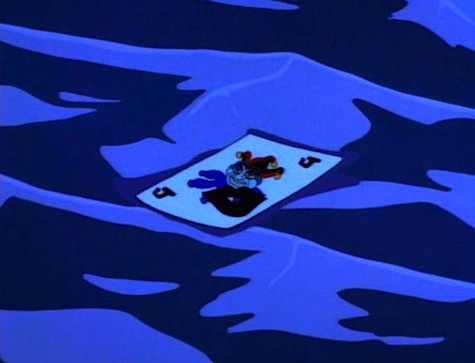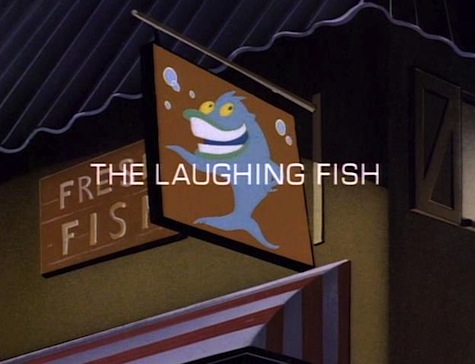“The Laughing Fish”
Written by Paul Dini
Directed by Bruce W. Timm
Episode #033
Music Composed by Shirley Walker
Animation by Dong Yang Animation Co., LTD.
Original Airdate – January 10th, 1993
Plot: The Joker has given every fish in Gotham harbor his face, and threatens to kill bureaucrats, one by one, until they let him have the copyright.
“The Laughing Fish” is the first Dini and Timm episode since the Emmy winning “Heart of Ice.” It’s also an adaptation of two classic comics from the ’70s, Steve Engelhart and Marshall Rogers’ “The Laughing Fish,” for most of the plot, and Denny O’Neil and Neal Adams’s “The Joker’s Five-Way Revenge,” for the finale in the shark tank. Those comics redefined the Joker as a serial killer (rather than a colorful bank robber), bringing him back to his debut in Batman #1 where he would announce his murders on the radio beforehand. These stories have influenced every portrayal of the Joker that followed, especially The Dark Knight Returns, Tim Burton’s Batman, and, of course, Batman: The Animated Series. As such, “The Laughing Fish” has quite a legacy to live up to. And it’s okay.
There’s nothing wrong with “The Laughing Fish.” There’s just not a lot that’s great about it. The animation is okay. Batman fighting a shark is always cool, as is the brutal backhand he gives the Joker at the end. The score is okay. Moody, quiet, even gone for long tense stretches. The jokes are pretty good (I still crack up at “Great Scott.” “Actually I’m Irish”). It’s neat to see them eschewing formula by replacing the usual title card with an ominous, creaking, swinging advertisement for laughing fish. But there’s not much that stands out.

Perhaps because the original stories are such a strong influence, there’s not a lot new here about the Joker. We’ve seen him be an attention hog and take over the airwaves, we’ve seen him target innocent men for fun, we’ve even seen him use his laughing gas as a way of getting a lot of money (though the effects of the gas, with the bulging eyes and rictus grins, are much more horrifying here than they were in “The Last Laugh.”) If anything, the biggest revelation here is that the Joker is half brilliant criminal and half idiot. When it comes to killing people in inventive ways, he’s all over that. But when it comes to actually making money, which he is interested in, he has no idea what he’s doing.
The best parts of the episode are the characters that Dini and Timm added, Harvey Bullock and Harley Quinn. Bullock is particularly delightful in this episode, because he’s almost always right when Batman is wrong (the exception being charging into Joker’s headquarters with no back-up). Batman is a “glory-hogging long underwear-wearing geek” interfering with police business, dressing the second victim in a Bat-suit is a waste of time, and Bullock understands in a second what it takes Batman a minute or two to figure out, that the Joker is getting his fish from the aquarium. When Bullock asks Batman to “just give him one for me” after being rescued, it’s the moment of mutual respect that’s missing from “Vendetta.”
As for Harley Quinn, we see a little more of her character here than we did in “Joker’s Favor.” Before, Harley was just a cheerleader. Here we see that she is the Joker’s abused girlfriend. And the show is not shy about the abuse. We see the Joker make her eat fish against her will, hit her with a fish costume, and when Bullock (who, again, is right about everything) calls him a “demented, abusive, psychotic maniac,” Harley can only agree and cry about how much she’ll miss him.

The other thing to note is George (the ’d’s are silent) Dzundza plays the first victim, G. Carl Francis. He’ll use the same high, Piglet-esque voice when he comes back as the Ventriloquist. But that is not the only voice he’ll be using….
He’ll also voice Perry White.
“Night of the Ninja”
Written by Steve Perry
Directed by Kevin Altieri
Episode #034
Music Composed by Mark Koval
Animation by Dong Yang Animation Co., LTD.
Original Airdate – October 26th 1992
Plot: A thief is targeting Wayne Enterprise, a ninja who Bruce Wayne trained with before becoming Batman, someone Bruce was never able to defeat on his own.
This is one of the best episodes of the series. I don’t see it in many top ten lists of best episodes, but it has a challenging and unique villain, a good plot, exciting action, and does more to develop the characters of Bruce Wayne and Dick Grayson than any episode previously. If only there were a good metaphor for an episode like this, something that quietly, quickly, and effectively gets the job done without drawing any attention to itself….
Anyway, if there’s a reason that “Night of the Ninja” gets passed over, it’s because the villain is superficially boring. He’s called “the ninja.” He looks like a ninja. Maybe in 1992 America hadn’t gotten over its love affair with the masters of shadow arts, but by 2013 the Inverse Law of Ninja has kicked in and they are just another type of thug.

But just under his plain exterior, Kyodai Ken is one of the most compelling villains of the series. First, out of costume, Kyodai is visually unique, with his bald head, douche-y goatee, and giant-ass oni tattoo. I couldn’t point out one particular ninja in a crowd, but I could find this smiling dipstick anywhere. (As he has his tattoo at the dojo, Kyodai was implicitly already yakuza before he started training, making his accusation that Wayne drove him to crime even more ridiculous.)
Secondly, Kyodai’s animosity towards Bruce Wayne is rooted in class resentment, always a favorite topic around these parts. Voice actor Robert Ito constantly sneers “rich man,” or more insultingly, “rich man’s son,” at Bruce, implying Wayne lucked into everything he had, as if Bruce wasn’t training at the same dojo even harder than Kyodai was. (Ironically, if Bruce was living the life he wishes he had, Kyodai’s insults would be accurate, but then Bruce never would have traveled to Japan to meet Kyodai in the first place). Kyodai’s whole modus operandi is taking what Wayne has and using it as his own, down to turning a Wayne Enterprises warehouse into his headquarters.
And finally, Kyodai being trained at the same dojo implies he’s Batman’s martial match, if not his superior. He defeats Batman in their first fight and in the flashbacks, so there’s tension each time he appears. We haven’t seen Batman take on an opponent he doesn’t think he can defeat before, even the crocodile monster and living mudslide. Kyodai Ken is the man who scares Batman (predating Bane in that position by a few months). Batman’s victory isn’t so much that he defeats Kyodai, as the ninja escapes at the end, but that he learns he can defeat Kyodai.
Writer Steve Perry created a great villain for the series in Kyodai Ken, one I wish had made the translation to the comics and other media. In the comics, the villain with a strong tie to Bruce Wayne’s past is the vastly inferior Hush. I think Kyodai Ken was a big influence on Christopher Nolan’s decision to recast the Arabic League of Assassins as the Japanese League of Shadows. In Batman Begins, after all, Ra’s Al Ghul is a man tied to Bruce Wayne’s training, who resents Wayne’s wealth, and who may be his superior in a fight. He’s basically Kyodai Ken with different unfortunate facial hair.
Additionally, “Night of the Ninja” develops the Batman/Robin relationship better than the entirety of “Robin’s Reckoning.” There, Batman cut Robin out of a manhunt because he was worried about losing Robin, but Tony Zucco was nothing but a paranoid schlub. Here, Kyodai Ken is “The Man Who Defeated Batman,” so Batman has better reason for fearing for Robin’s life. Every time Robin jumps in, there is a real threat to Robin and a real sense Robin is saving Batman’s life, not just helping him out of an inconvenience.

And Batman finally figures out that he can and should trust Robin. Batman has been training Robin for nine years by now, well enough that Robin is evenly matched with, if not actually better than, Kyodai Ken. (In a small but dickish move, Bruce still hasn’t promoted Dick over the rank of green belt.) Robin is also capable of learning on the fly, wondering how Kyodai disappeared after falling off a building, then recreating the trick when Kyodai hits him with a water tower.
And importantly, Robin knows when not to interfere. He could have jumped in at the end and helped Bruce double team Kyodai. Instead, he covers Summer Gleason in a carpet, hiding Bruce’s skills from the press and giving Bruce the chance to prove, to himself and to Kyodai, that Batman can and will kick your ass if you step up to him. Batman thanking Robin for his help at the end is hard won and very satisfying.
Kevin Altieri does his usual stellar job as director, with a great series of well choreographed fight scenes and tense, sepia toned flashbacks. Batman’s first confrontation with Kyodai, where the shadow of the bat turns out to be just some passing clouds that hide his actual appearance, is a great gag, as is Bruce’s change in body posture once Summer is out of the picture and he can be “himself” out of costume. That scene, where Bruce would let himself get the crap kicked out of him rather than compromise his secret identity, is crucial to any understanding of Batman.

Steven Padnick is a freelance writer and editor. By day. You can find more of his writing and funny pictures at padnick.tumblr.com.











